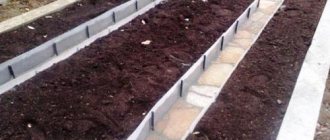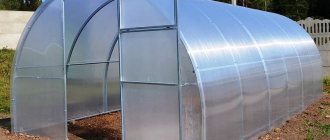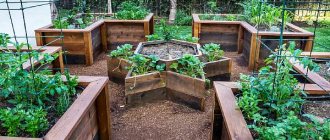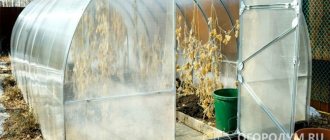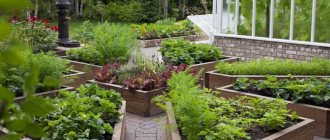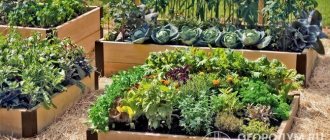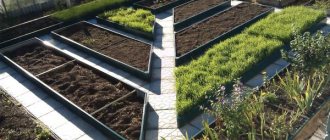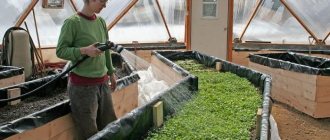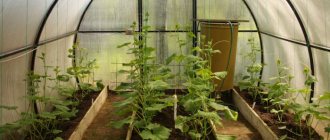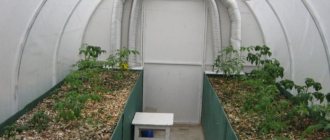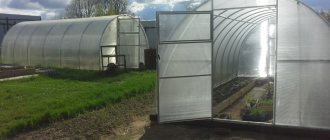How to make beds from boards with your own hands in order to significantly simplify the process of caring for a vegetable garden and increase productivity is a question that requires detailed study. They can be made from the lumber that remains after building a house, barn, veranda, etc. However, before you start building a garden bed at your dacha, you should familiarize yourself with the main nuances of performing this work.
Garden beds at the dacha
Main features
Boards are the best option for making fences. You can buy them or use lumber already available on the farm. Before you make beds from boards, you need to decide which border option to choose for this.
The WPC board fits quite tightly to the ground during installation, leaving no visible gaps.
Moreover, the box made of wood boards perfectly retains moisture, thanks to which the plants germinate faster.
Courtyard interior
Garden fencing boards have the following features and advantages:
- acceptable price;
- ease of container assembly;
- ease of maintenance in the greenhouse;
- aesthetically attractive appearance;
- durability with proper care.
The photo shows a border made of boards.
Boxes made of boards
Fence sizes
Before you start making the box, you need to decide on its dimensions. It is difficult to give wood a shaped shape, so the frame is made rectangular.
When making a box, the guideline is based on the following parameters:
- Height. The value is within 15-20 cm. It is not recommended to raise it higher. This is due to increased material consumption. In addition, in winter, the black soil freezes, expands, and the middle part of the box expands. If a warm bed is formed, then it rises to a height of 70 cm.
- Width. This size depends on the height of the person working in the garden. Usually it is in the range of 90-120 cm. According to other calculations, this value is half the employee’s height. The main thing is to be able to reach the middle of the box with black soil from any side.
- Length. This size is a free size. However, in order not to weaken the rigidity of the structure, they adhere to the value of 4-6 m. By investing within these limits, you can be sure that the side walls will not bend outward.
The number of boxes depends on the size of the garden and the type of products grown. The distance between the beds is left such that free movement is ensured. With this planting, crops receive sufficient lighting.
Advantages and disadvantages of this solution
Before you start assembling the box with your own hands at the dacha, we recommend that you familiarize yourself with the existing advantages, of which there are many:
- Having made a high bed from lumber, it is subsequently easy to maintain and care for planted vegetable crops.
- To fence the beds with your own hands, you can use both lumber that is already on the farm, and pre-purchased (beds made from decking boards, etc.).
- If the country terrace is predominantly dominated by infertile soil, bulk boxes made of lumber will correct this problem. In this case, it is recommended to make embankments from purchased fertile soil.
- This technology will help you get an impressive harvest even on rocky terrain.
- Thanks to the container made of boards, the bulk soil will not sag or spread.
- You can build beds in a greenhouse from lumber, but before doing this they should be treated with special means.
- Wood is an environmentally friendly material, which is also of great importance. You don’t have to worry about toxic elements penetrating into the soil.
- The wood does not heat up too much in the sun, as a result of which the plants will not get burned.
The photo shows a high bed.
Preparation
In addition to the above-mentioned advantages of beds made of boards, you should also not forget about the aesthetic side of the issue. After all, wood fits perfectly into the country landscape, favorably emphasizing its originality and beauty. This fence can be painted in absolutely any color. Summer residents often paint boxes greenish, although this is a matter of taste.
Since the main advantages of this solution are already clear, it is worth considering the existing disadvantages. The service life of containers made of wood is insufficiently long. Wooden beds in a greenhouse or greenhouse are especially subject to wear and tear due to high humidity and high temperature.
However, this can be easily corrected by processing the wood yourself using special tools. Treated lumber will last much longer for edging a vegetable garden.
Construction of the “pie”
Typically, wooden boxes for beds are installed on existing soil without going deep into it. Fixation is carried out using stakes at the corners of the structure. They can be made of wood, but a metal profile with a square cross-section is much more reliable. Before assembly, a protective impregnation, for example, BIO Cedar, is applied to the walls.
Initially, we have two boards, 2 cm thick and 300 cm long. We cut each into two parts, 80 cm long and 220 cm long. There should be 4 parts in total. We attach them to ready-made metal pegs using roofing screws. The height of the side is two boards, that is, 30 cm. The length of the “free” leg is 20 cm.
Drill 4 holes along the edges of the walls.
First we assemble the end sides.
Then we attach longitudinal ones to them. We put the frame in place. We bury the legs into the ground, making sure that the upper edges are parallel to the ground. We check with a level whether the structure is level.
Related article:
Here's what you can plant in the garden after harvesting winter garlic
With a two-meter length, it is not necessary to make transverse ties or external supports. But if the length of the frame is three or more meters, they are necessary. It is advisable to attach the timber to a galvanized corner, which will help prevent the wooden elements from loosening in the future.
To make the screed, the vertical beams are screwed from the inside with self-tapping screws to the opposite walls, and then connected with a horizontal strip. After installation, the lower edge of the frame is sprinkled with sand or earth, which must be compacted well.
Filling the “pie”
A fine mesh construction mesh is laid at the bottom of the frame. It will protect the plantings from moles and mice. The mesh must be placed on the walls and secured with nails. The next layer can be laid geotextiles. The further arrangement of the “pie” depends on the humidity of the area. If groundwater levels are high or flooding is possible, good drainage is necessary. It uses crushed branches, bark, construction waste, pebbles or large wood shavings.
The next layer is compost. Last year's leaves, bird droppings, mown grass, and tops of garden crops are suitable. There is a lot of such material, since the “pie” is made in mid-autumn so that everything has time to rot before spring planting. At least 20 cm of fertile soil is poured on top. If the soil on the site is poor in composition, use an imported mixture.
This is another advantage of organic plantings - you don’t have to reclaim the entire garden plot, which would be much more expensive.
Mulch protects the fertile layer from drying out. Its role can be played by grass, pine needles, straw, sawdust, crushed bark. The purpose of mulching is to retain water at the roots of plants, prevent the growth of weeds and enrich the soil.
In dry areas with a lot of sun, it is not necessary to resort to drainage. The bottom layer is made of loam and sandy loam, trying to stop the moisture not from below, but from above, to keep it inside the “pie”. Next, compost is laid, and grass is placed on top of it. A small layer of sawdust will increase soil permeability and improve air exchange. Lastly, humus or chernozem is added, depending on the crops that are supposed to be grown.
All layers must be compacted so that they subsequently sag less. After that, the self-made bed is poured generously with warm water, starting the fermentation processes. It is recommended to additionally use biological products “Baikal” or “Siyanie”, containing beneficial microflora. In winter, the structure is covered with agrotextiles to avoid freezing, weathering and the introduction of weed seeds.
The yield on beds lined with boards is several times higher than on traditional ones.
Classification of existing types of boxes
Some gardeners prefer open mounds, while others, more experienced, use wooden containers.
Wooden boxes
There are various types of boxes that differ in their characteristics and purpose:
- No fences. It differs from the usual one in its height. The dimensions of the beds are 75 cm high, 100 cm wide. The distance between the elements is 40 cm. Bulk elements are mainly made in areas with infertile soil. However, there is a main drawback of this solution - such embankments tend to creep away over time.
- Container. You can make a garden bed from simple lumber. A good solution would be to use coniferous wood to assemble the box: spruce, pine or fir. Unlike open ones, this solution does not allow the soil to crumble over time.
- Raised box. A raised bed is also made from wood or other material, such as slate. The height of such a dacha device can reach up to 90 cm, and the width - up to 75 cm. Such a box leads to a greenhouse effect, which has a beneficial effect on the yield as a whole.
- A narrow bed has a width of no more than 0.5 m. Plants are planted in such boxes in two rows from the edges. Narrow beds in a greenhouse are the most successful solution.
The photo shows a tall vegetable garden made of boards in a country house.
Filling the bed
Garden beds in open ground
Don't like original solutions, preferring classics? Then use regular beds. The soil needs to be dug up and harrowed, after which beautiful, neat rows are formed. The width depends on the crop being grown and your habits. To ensure that the edges are even, you should pull the cord and dig up the beds, harrow, and then rake the sides. If desired, you can trim the edges with your own hands using brick, timber or other materials. Well, if you think that it is better to make high beds in the garden, then after studying the theoretical part, there will be no problems.
Plastic structures
Products made from polymer elements favorably emphasize the perimeter of plantings. In addition, plastic beds come in different colors and textures, so you can create a unique landscape design.
Plastic is a fairly rigid barrier, which subsequently separates the landing zone.
The plastic elements are flexible enough to give the structure any shape.
Due to the fact that plastic beds do not absorb moisture and are not affected by temperature changes and direct sunlight, they can be collected in different climatic zones.
In the courtyard
The garden plastic board used can be of different textures:
- brick;
- natural stone;
- wood texture;
- metal and much more.
It must be admitted that beds made of PVC boards are much more durable than those made of lumber. They are reliably protected from rotting.
Also, if desired, the plastic box can be moved from place to place, which cannot be done when the structure is stone, brick or iron. In fact, plastic fences are mobile structures that do not require specific maintenance.
Design diagram
In addition to the above advantages, plastic parts have the following features:
- Simple and relatively quick installation. Using plastic elements for the garden bed, you will eventually be able to assemble a box in the shortest possible time. The plastic does not need to be further processed or placed on a bonding material. You just need to create a configuration of a suitable shape, and then fill it with fertile soil.
- Polyvinyl chloride is characterized by increased wear resistance and practicality. Structures made from this material are designed for a fairly long service life. Moreover, polyvinyl chloride is a lightweight material, which makes it possible to design multi-tiered country houses. If you make beds for strawberries, tomatoes or cucumbers from polyvinyl chloride with your own hands, then this will be an excellent solution.
- A huge selection of plastic models and excellent decorative qualities. You can choose elements of different textures, which will allow you to decorate your summer cottage and give it a zest.
- Mobility. If desired, decorative composite fencing can be quickly and easily dismantled or moved. There is corresponding video material on this topic on YouTube.
- No additional care. Unlike the same wood box, a PVC border does not require special processing. Over time, it does not need to be varnished or painted, since PVC does not absorb moisture and does not deteriorate when exposed to direct sunlight.
Options for wooden borders
Original options for high ridges
Having understood the principle of assembling a simple rectangular structure, it can be modernized in a way that suits you. It all depends on desire and imagination. Wood is such a “flexible” material that with its help, hardworking owners of their gardens and summer cottages create real masterpieces of design art.
Here are just a few examples with photographs:
Pyramid bed
Excellent for growing strawberries, spicy and medicinal herbs when there is a shortage of space, creating multi-tiered flower beds or an alpine slide
Fence bed
An ideal option for zoning the territory. Instead of a classic fence, you get additional places for planting or flower beds
Bed-wall
Allows you to increase the usable area of the site and decorate the blank walls of buildings
Compositions from non-standard shapes
Nobody forces boxes to be strictly rectangular or square - trapezoids, polygons, and circles have a place on the site
Beds-benches for a recreation area
If you want to relax on a comfortable bench, admire the flowers and enjoy the harvest at the same time, combine a classic bench with equally classic box beds
Another example of a bed-bench
Further care
Of course, it is necessary to water and feed germinating plants in a timely manner. The frequency of watering is a couple of times a week. Also, do not water with an intense stream of water, as this can destroy the base layer.
Today, many gardeners prefer to use an automated watering system for strawberry or cucumber beds, which provides the plants with constant access to water and significantly saves gardeners time.
Gryadochka
It is also necessary not to forget about additional care of wood, in particular its periodic processing.
It is recommended to renew the layer of paint or varnish every six months, which will make the lumber last much longer.
